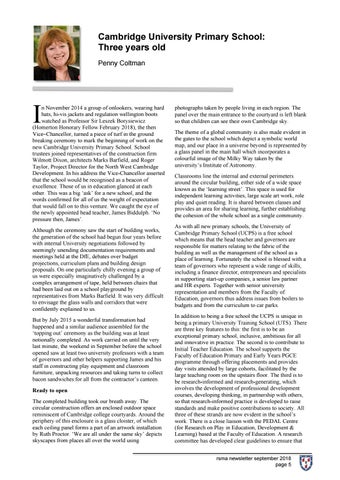Cambridge University Primary School: Three years old
I
Penny Coltman
n November 2014 a group of onlookers, wearing hard hats, hi-vis jackets and regulation wellington boots watched as Professor Sir Leszek Borysiewicz (Homerton Honorary Fellow February 2018), the then Vice–Chancellor, turned a piece of turf in the ground breaking ceremony to mark the beginning of work on the new Cambridge University Primary School. School trustees joined representatives of the construction firm Wilmott Dixon, architects Marks Barfield, and Roger Taylor, Project Director for the North West Cambridge Development. In his address the Vice-Chancellor asserted that the school would be recognised as a beacon of excellence. Those of us in education glanced at each other. This was a big ‘ask’ for a new school, and the words confirmed for all of us the weight of expectation that would fall on to this venture. We caught the eye of the newly appointed head teacher, James Biddulph. ‘No pressure then, James’. Although the ceremony saw the start of building works, the generation of the school had begun four years before with internal University negotiations followed by seemingly unending documentation requirements and meetings held at the DfE, debates over budget projections, curriculum plans and building design proposals. On one particularly chilly evening a group of us were especially imaginatively challenged by a complex arrangement of tape, held between chairs that had been laid out on a school playground by representatives from Marks Barfield. It was very difficult to envisage the glass walls and corridors that were confidently explained to us. But by July 2015 a wonderful transformation had happened and a similar audience assembled for the ‘topping out’ ceremony as the building was at least notionally completed. As work carried on until the very last minute, the weekend in September before the school opened saw at least two university professors with a team of governors and other helpers supporting James and his staff in constructing play equipment and classroom furniture, unpacking resources and taking turns to collect bacon sandwiches for all from the contractor’s canteen. Ready to open The completed building took our breath away. The circular construction offers an enclosed outdoor space reminiscent of Cambridge college courtyards. Around the periphery of this enclosure is a glass cloister, of which each ceiling panel forms a part of an artwork installation by Ruth Proctor. ‘We are all under the same sky’ depicts skyscapes from places all over the world using
photographs taken by people living in each region. The panel over the main entrance to the courtyard is left blank so that children can see their own Cambridge sky. The theme of a global community is also made evident in the gates to the school which depict a symbolic world map, and our place in a universe beyond is represented by a glass panel in the main hall which incorporates a colourful image of the Milky Way taken by the university’s Institute of Astronomy. Classrooms line the internal and external perimeters around the circular building, either side of a wide space known as the ‘learning street’. This space is used for independent learning activities, large scale art work, role play and quiet reading. It is shared between classes and provides an area for sharing learning, further establishing the cohesion of the whole school as a single community. As with all new primary schools, the University of Cambridge Primary School (UCPS) is a free school which means that the head teacher and governors are responsible for matters relating to the fabric of the building as well as the management of the school as a place of learning. Fortunately the school is blessed with a team of governors who represent a wide range of skills, including a finance director, entrepreneurs and specialists in supporting start-up companies, a senior law partner and HR experts. Together with senior university representation and members from the Faculty of Education, governors thus address issues from boilers to budgets and from the curriculum to car parks. In addition to being a free school the UCPS is unique in being a primary University Training School (UTS). There are three key features to this: the first is to be an exceptional primary school, inclusive, ambitious for all and innovative in practice. The second is to contribute to Initial Teacher Education. The school supports the Faculty of Education Primary and Early Years PGCE programme through offering placements and provides day visits attended by large cohorts, facilitated by the large teaching room on the upstairs floor. The third is to be research-informed and research-generating, which involves the development of professional development courses, developing thinking, in partnership with others, so that research-informed practice is developed to raise standards and make positive contributions to society. All three of these strands are now evident in the school’s work. There is a close liaison with the PEDAL Centre (for Research on Play in Education, Development & Learning) based at the Faculty of Education. A research committee has developed clear guidelines to ensure that rsma newsletter september 2018 page 5
